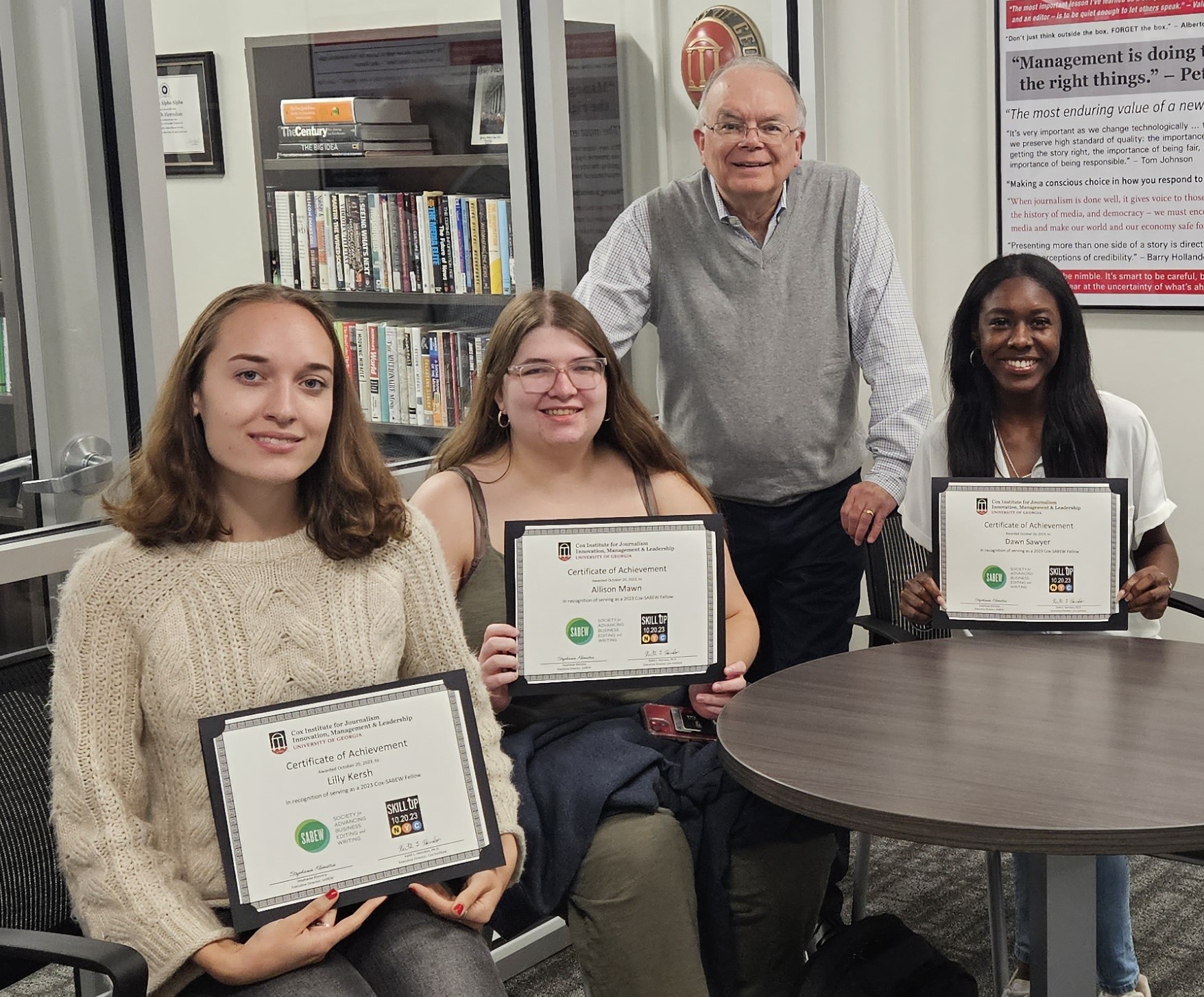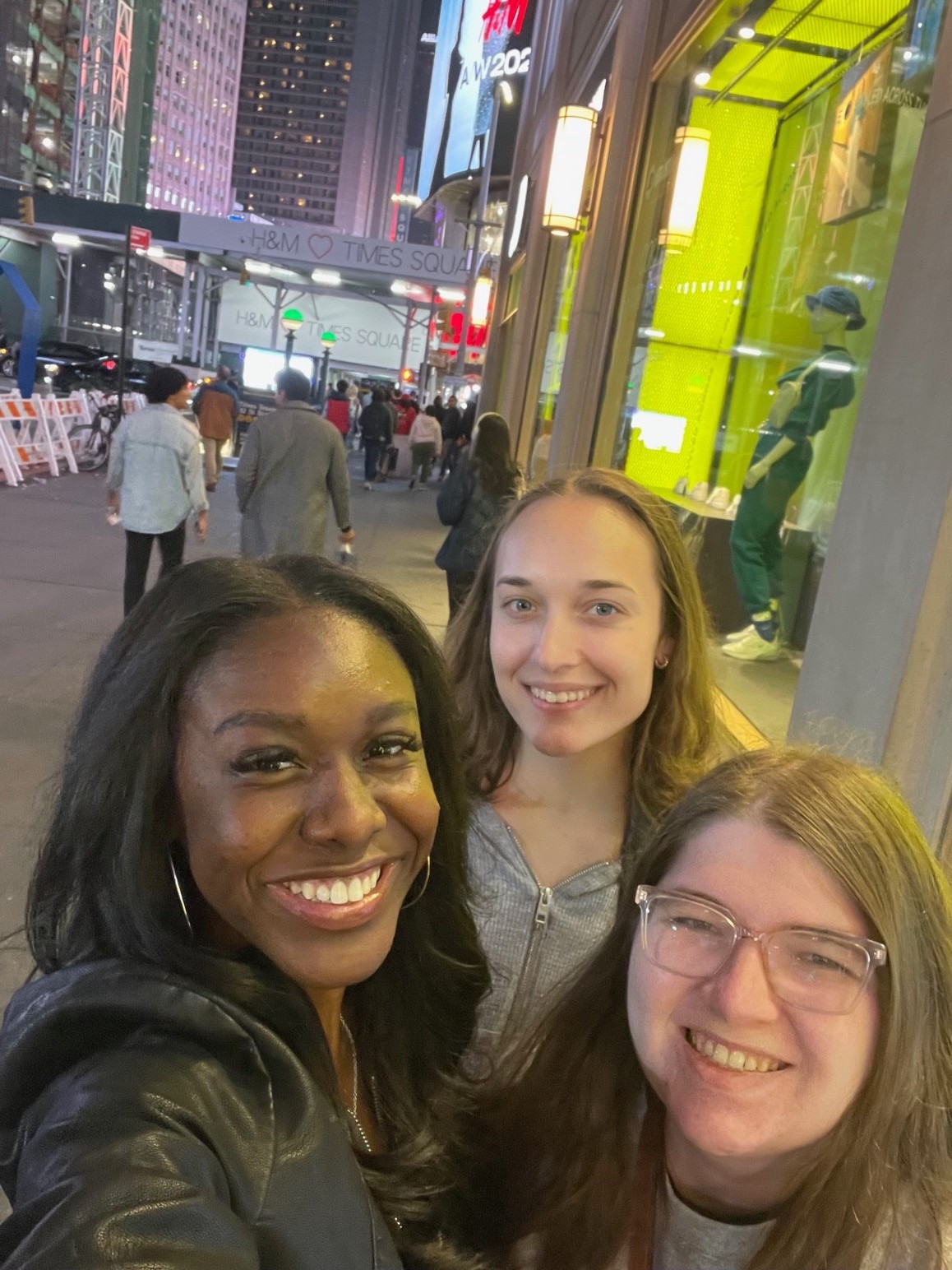Cox-SABEW Fellows Attend Skills Workshop at Wall Street Journal

Cox-SABEW Fellows Attend Skills Workshop at Wall Street Journal
Three University of Georgia journalism students attended this year’s SkillUp workshop sponsored by the Society for Advancing Business Editing and Writing (SABEW).
The students, Lilly Kersh, Allison Mawn and Dawn Sawyer, participated as part of a fellowship funded by UGA’s Cox Institute for Journalism Innovation, Management and Leadership. The students are designated as this year’s Cox-SABEW Fellows.
The SkillUp workshop, held at the Wall Street Journal offices, featured an afternoon of professional development sessions and career networking opportunities. The Cox-SABEW Fellows wrote summary articles about each of the skills sessions that are posted below.
First Session: The Scoop on Landing Scoops
By Dawn Sawyer
Two Wall Street Journal reporters said successful journalists must be dedicated to their craft and be willing to proactively learn about different beats.
Laura Cooper and Lauren Thomas, who report on mergers and acquisitions, shared their professional advice at the SkillUp Workshop sponsored by the Society for Advancing Business Editing and Writing at the Wall Street Journal headquarters in New York City on Oct. 20.
The two reporters presented the first session titled, “The Scoop on Landing Scoops,” which presented tips on how to be the first to break news in an industry full of talented, competitive journalists.
“You’re chasing things constantly,” Thomas said. “They don’t fall into your lap.”
Both reporters had experience working in local newspapers, and they noted that many of the skills developed there have transferred over to what their job requires of them now. They are involved in covering a variety of topics including retail, private equity, fundraising and economics.

Both reporters spoke on the variety of breaking news stories they have been a part of over the years, from deals with Subway and Simon & Schuster to a $60 billion ExxonMobil deal and Tapestry buying Capri.
The reporters said a key component to reporting breaking news is mastering the skill of sourcing, which means building trust with subjects and continuously following up.
“If you don’t have the relationship, you don’t have the story,” Thomas said.
The two also shared that gathering material from people of various positions and levels of expertise allows them to create the most informative and impactful articles. Thomas suggested journalists make a list of questions tailored to each source, based on who they are and what they may know given their field of expertise and experience.
Cooper noted that when meeting new sources, she values going in person and shaking their hands rather than meeting on Zoom. She finds that in professions such as journalism, being a person who enjoys talking and connecting with others, especially face-to-face, is valuable to the job.
When describing their typical day as M&A reporters, Cooper and Thomas said their busiest day of the week is often Merger Mondays. This term refers to the frequency of companies that finalize their deals over the weekend and announce their plans the following Monday.
In her previous role at CNBC covering retail for companies like Kohl’s and Peloton, Thomas found that it was easier to get into a routine of covering the companies and knowing what was coming next. In her current role, she said it is the complete opposite, calling her schedule unpredictable.
“Sometimes you’re chasing a story, and it just takes time,” Thomas said.
Cooper explained it as being like a puzzle. There are a variety of factors that come into play with M&A reporting that require both patience and perseverance. While it is important to give the story time to breathe, it is equally important to keep in contact with sources throughout the process, and to most importantly, not give up.
“It’s the thrill of the chase,” Cooper said. “The highs are very high in this field and the lows are low, so you’re always chasing the highs.”
Second Session: From Data Point to Story
By Allison Mawn
Nichole Sadek, a data reporter for Bloomberg Law, wants people to know that data journalism is still journalism.
“It’s not just data analysis,” Sadek said. “You don’t just sit at your computer and find means and analyze trends and you know, find minimums and maximums. That’s definitely part of it. You will be doing that if you’re doing a data driven project. But more than analysis, it’s just journalism.”
The Society for Advancing Business Editing and Writing hosted the SkillUp Workshop at the Wall Street Journal headquarters in New York City on Oct. 20. Sadek presented the second session: “From Data Point to Story.”
Sadek spent some time clarifying what data journalism is and is not, before explaining some of the key steps and how it can be used in a journalist’s work. She defined data journalism as “reporting newsworthy facts using structured data.”
Sadek outlined the broad steps of data journalism: developing a question; collecting and analyzing documents; compiling, cleaning and analyzing data and interviewing sources. Sadek emphasized having a “data state of mind” and said data journalists must consider if data exists about the question they want to answer and where they can find the relevant data.
Sadek debunked a few data journalism myths, namely that data journalists have to like math, be programming geniuses and have a computer science degree.
Sadek dove into what to look at when gathering data: who collected and maintains it, how was it collected and what each column and row of a spreadsheet means. She also noted that data is often dirty, meaning it has missing elements, misspelled words and such, requiring the data journalist to clean it up for analysis.
In providing a practical example of data journalism, Sadek discussed a story she had recently been involved with about federal judges’ race and the populations they represent. She explored pulling data from multiple sources and converging datasets, as well as having to rethink the central question based on what the data could actually show. Sadek said that such pivoting is common in data journalism.
“You don’t know what speed bumps you’re going to hit until you hit them,” Sadek said.
Third Session: Raise Your Game and Get Booked
By Lilly Kersh
The key to a good story pitch, according to a panel of CNBC journalists, is to know your outlet, network and audience.
The panel, “Raise Your Game and Get Booked,” was the third session of the SABEW SkillUp Workshop held at the Wall Street Journal’s headquarters Friday, Oct. 20. The CNBC panelists, examined the art of the pitch — how to pitch, prepare and present to news networks and get booked on air.
“The Exchange” senior line producer AJ Vielma said the pitch has to be actionable not just for the network but for the audience, too. Explaining why news matters to a consumer is as important as breaking news itself. News value and timeliness are the basic requirements of any good pitch, the panelist said.

Nasdaq reporter Kristina Partsinevelos said she will spend 75% of her time doing the work of journalism and the other 25% pitching herself and her reporting. But the journalists don’t just pitch to networks — they gain trust by pitching themselves to sources.
CNBC.com’s managing editor Jeff McCracken suggested being “long-term greedy” with sources.
“In other words, don’t stab them in the back … It’ll be years until you get something out of it, but it will work,” McCracken said.
Establishing long-term, quality source relationships requires you pitch yourself, as a journalist, to others.
“Being a good journalist is about having good sources,” McCracken said. “You have to sell yourself to your sources.”
Pitches should be targeted and focused, and you should be able to communicate the point quickly. The panelists advised finding the decision makers, and tailoring the pitch to the network or show, to deliver your pitch most effectively. Thorough vetting for spelling errors and checking if an email is addressed correctly are also crucial, Partsinevelos said.
Partsinevelos recommended setting up background calls with analysts and other experts to establish expertise in a field. She said it took her a year to gain enough knowledge on her beat, semiconductors, to be able to report on it effectively. But having a beat, she said, can help establish you as a journalist.
“When you don’t have a beat it makes it harder to start your career,” Partsinevelos said.
Partsinevelos studies her beat and the people she connects with as if studying for a test. The anchor is the proctor, and going on air is the exam. Vielma echoed this metaphor, comparing the immersion of beat reporting to the experience of studying abroad.
When preparing to pitch to a network, the panel agreed that researching their reporting is key. Read and watch their reporting and come into the meeting with at least two pitches for stories that they have not told.
“Know what you’re getting into. Do your research [on the network],” Kevin Flynn, executive producer of “Halftime Report,” said.
The panel also recommended developing multiplatform skills to present not just through writing, but through social media and other digital platforms.
They also recommended channeling anxiety and nerves into positive energy, maintaining an engaged demeanor and body posture. For remote interviews, make sure to have good connectivity, framing, lighting and audio.
For a good pitch, they advised journalists to engage with knowledge, passion, confidence and authority.
“Do you care about this? Are you obsessed with it?” McCracken asked. “That’s what separates a great journalist [from] a mediocre journalist … I want to see that obsession to be a great journalist.”